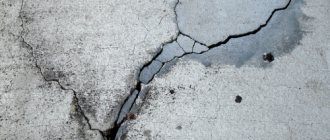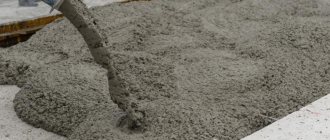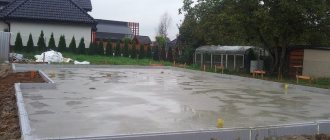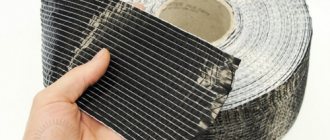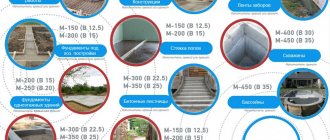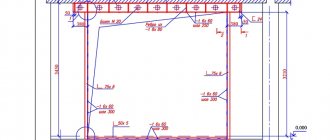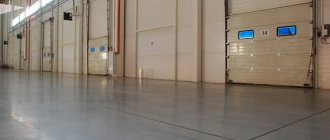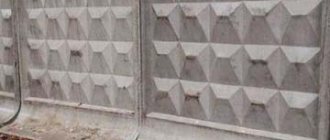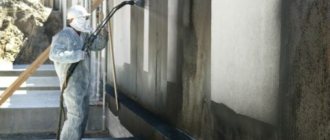Review of impregnations from different manufacturers
You can find a large selection of concrete impregnations on sale, but only some models are worthy of attention.
Strengthening primer for concrete floors Protector
The product is intended to remove dust from the surface and increase the resistance of the material to chemicals. Impregnation is in demand in the construction of concrete surfaces for various purposes. Among them:
- Floor coverings.
- Street paths.
- Runways.
Strengthening – Retroplate
The product is used to remove dust and increase the strength properties of low-grade concrete (less than M300), as well as to restore old floors with a mosaic surface.
When starting treatment with this composition, it is important to pay attention to the following features:
- Impregnation is not intended for uncured concrete (waiting time - about 2 weeks).
- Application of the composition is permitted at a temperature of at least +5°C.
The cost of 1 liter of such impregnation is 400 rubles.
Organic – Protexil
This series of impregnating solutions for concrete floors is intended for industrial buildings. It provides a high degree of protection against aggressive influences and has the following properties:
- Penetration depth - 5-10 mm.
- Consumption - 0.3 l per 1 m2.
- Operating temperature - within -40...+80°С.
- Drying interval - up to 6 hours at a temperature of +20°C.
1 liter of floor impregnation - 175-195 rubles.
Universal – Monolit 20-M
The product is water-based, so it meets all environmental safety requirements and is protected from fire.
As a result, the impregnating agent has the following effects on the concrete product:
- Improves the moisture resistance of the material by 3 grades.
- Increases wear resistance and strength by 30%.
- Eliminates the problem of concrete warping and cracking.
- Removes dust from the surface.
- Provides good adhesion.
- Increases resistance to organic acids and petroleum products.
For 1 m2 of product area, 3-5 liters of impregnation are required.
Aquastone
The product is intended for removing dust from the surface of concrete pavement and screeds based on a cement-sand mixture. Impregnation is characterized by deep penetration and guarantees an increased degree of strength and hardness. 1 l - 240 rub.
Aquasol
This impregnation of a concrete floor is intended to isolate the structure from moisture and precipitation. The cost of 1 liter of the substance is 210 rubles.
Epoxol
This is an epoxy water-dispersed impregnation that is used to increase the strength properties and protect concrete structures from destruction. With its help, you can achieve a 2-3-fold increase in strength and resistance to intense loads. Epoxol is applied to wet concrete and is indispensable for food and pharmaceutical industries, medical institutions and public buildings. 1 liter of product - 380 rub.
Ashford Formula
The product consists of water-based silicate polymers and increases the strength of concrete coatings. 1 liter of substance -110 rub.
Protecting the foundation from destruction - methods of implementation and reasons for concern.
During operation, the underground part of the house is subject to significant loads, so its construction should be approached responsibly. Timely identification of weak soil layers, carrying out calculations and following installation technology will help get rid of a lot of problems, including uneven settlement of the building, which is fraught with deformations and destruction of the entire structure. First of all, the foundation must be protected from moisture, since water is its main enemy. Its negative impact causes destruction of the underground part of the house and the basement, characteristic cracks appear on the walls, and doors and windows stop closing.
How to protect the foundation of a house from destruction.
Features of use
Hydrophobic coatings intended for concrete are applied in two ways:
- Added to the solution during its preparation. The composition is distributed evenly and binds with other elements. The output is moisture-resistant and durable hydrophobic concrete.
- The surface of ready-made concrete structures is covered with a roller or brush. It is absorbed into concrete, passing through the capillaries of living stone. Forms a durable moisture-proof film. It is used before gesso walls, wallpapering, or before applying any other decorative coating.
Before applying to the base, it is necessary to remove dust and grease from the concrete wall and dry thoroughly. Then the hydrophobic impregnation is applied with a roller or brush. After applying the first layer, you need to let the wall dry. It is allowed to begin applying decorative materials to the surface of the structure only the next day.
Processing technique
Before applying the mixture to the concrete base, it is necessary to thoroughly sand it, clean it of the old top layer, various contaminants and dust.
Next, the components are thoroughly mixed using a construction mixer (speed 300-400 rpm). The prepared mixture should be used within an hour.
Impregnation is applied with a roller with polyamide fibers in 2-3 layers, depending on the absorbent qualities of the concrete base. After the first layer has been applied, it needs to dry for about 1.5 hours, then you can begin applying the second layer (drying time up to 2.5 hours).
Layers are applied until a uniform surface gloss is formed - if the solution is used as an independent coating. If the mixture is used as a primer, the surface should take on the uniform appearance of wet concrete.
Effect provided by concrete impregnations
Organic impregnations are currently most widespread. They are acrylic, polyurethane, epoxy.
Impregnating compositions based on acrylic have good qualities at an affordable price. The concrete treated by them is not susceptible to the effects of chlorides. He is not afraid of high humidity. It has high resistance to ultraviolet radiation. During operation, the color of the concrete does not lose.
These impregnations are used to eliminate the formation of dust on concrete floors, the load on which is insignificant. This process is repeated after 2 - 3 years of operation, since the durability of acrylic-based compositions is not so great.
The best effect is achieved by impregnations made on the basis of polyurethane. They also eliminate dust and provide inertness to chemical compounds. In addition, these impregnations significantly increase the strength of concrete and make it waterproof.
The depth to which such impregnations penetrate reaches six millimeters. They can be used to impregnate concrete screeds, concrete and metlakh tiles, and bricks.
The restrictions are the conditions prohibiting the use of such compositions in open areas without canopies, as well as the mandatory presence of waterproofing under the concrete.
The use of polyurethane impregnations increases the strength of concrete products. The resistance of concrete to wear increases eight to ten times. Its ability to withstand shock loads is doubled.
Concrete becomes waterproof and resistant to chemical compounds. By eliminating the formation of dust, floor maintenance becomes easier, and the appearance of the surfaces becomes aesthetically pleasing.
Classification of impregnations
Based on their content, impregnating compositions are divided into two types:
- organic (polymer);
- inorganic (silicate).
Organic water-repellent solutions affect concrete in the following way: the binder component fills the pores, improving the material’s ability to withstand aggressive influences and enhancing the water-repellent qualities of the coating. Impregnations also solve the problem of surface dustiness and improve its strength characteristics.
Inorganic impregnating compounds act differently. They do not target pores, but interact with external molecular compounds, which then dissolve and become immune to other reactions. As a result of the interaction, concrete gains higher strength and water resistance.
When choosing an impregnating material, it is recommended to take into account the following factors:
- Inorganic compositions are used for: dust removal at low cost, with significant surface unevenness, with heavy loads on the floor.
- Organics are relevant in the following cases: constant interaction with chemicals, maintaining an attractive appearance of the coating, the need for dust removal from mosaics.
Today, organics are the most common. This is due to the better functional characteristics of organic compounds.
Different impregnations differ in the method of influencing the concrete base:
- Deep penetration impregnating compounds (silicates, silaxins, silanes) promote the fluidization of concrete. The sealing components penetrate microscopic pores and interact with lime molecules, increasing the crystallization of calcium. Thus, fluates strengthen the material from the inside.
- Liquid waterproofing compounds form a thin protective film. An example is impregnation based on acrylates. Epoxy mixtures and numerous types of polyurethane impregnations also work.
Acrylic compounds
Impregnations based on acrylates are distinguished by affordable prices and acceptable quality. They protect the material from moisture and chlorides, are resistant to ultraviolet radiation, and preserve the natural color of concrete. Acrylic compounds allow you to remove dust from the coating. However, impregnations of this type are short-lived - their effect lasts no more than 24-36 months.
Polyurethane compounds
Polyurethane is more effective than acrylates. Impregnating solutions based on polyurethane remove dust from the surface, are resistant to chemicals, are moisture resistant, and provide strength. Polyurethane solutions are used to treat not only concrete, but also cement screeds, paving areas, stone and brick objects. Polyurethane penetrates deeply into the concrete layer (up to 6 mm) and is used both indoors and outdoors.
Note! The use of polyurethane compounds implies the presence of a waterproofing layer under the concrete base, which blocks the penetration of capillary moisture into the structure of the material. After treatment with a polyurethane solution, concrete acquires several new qualities:
After treatment with a polyurethane solution, concrete acquires several new qualities:
- Strength increases to M600 level;
- wear resistance increases by 7-10 times;
- Impact resistance doubles;
- water resistance and resistance to chemicals are improved;
- dust is eliminated;
- maintenance of the coating becomes easier;
- the appearance of the surface becomes more attractive.
Polyurethane impregnating compounds are easy to use and financially beneficial. The impregnated surface begins to be used on the same day, if we are talking about pedestrian traffic. In the case of transport, you need to wait three days for the concrete to gain maximum characteristics.
Epoxy compounds
Impregnations based on epoxy resin are used only indoors, as they do not withstand exposure to ultraviolet radiation and turn yellow. The composition is a mixture of two components, which includes epoxy resin and hardener. The latter are phenols or tertiary amines. The proportions between the hardener and resin may differ depending on the consumer characteristics of the product. Compositions are offered in both colored and colorless versions.
The advantages of epoxy impregnations include the following qualities:
- high strength;
- resistance to abrasives;
- moisture resistance;
- slight shrinkage;
- no pungent odor;
- attractive appearance, as the surface resembles “wet concrete”.
The disadvantage of epoxy compounds is that they are less resistant to chemicals and mechanical loads when compared with polyurethane impregnations.
Moisture-resistant soil - varieties
Additives to concrete for waterproofing differ in their purpose:
- Primers that increase the strength of the base. They are based on silicate compounds. The composition, being deeply absorbed into the massif, changes its structure. Increased wear resistance is ensured by the adhesion of the primer mixture to the base, which increases the wear resistance of the surface and removes dust from it. Detachment of a reinforcing coating that penetrates deeply into the structure of an array is almost impossible. The floor of the room, supporting structures, ceiling and walls are gradually covered with the primer mixture. The use of compositions based on lithium silicate increases the resistance of the surface to abrasive loads, high humidity, and impedes the formation of dust. The treated surfaces can be used 1-2 hours after applying the primer.
- Water-repellent compounds. They contain water-repellent additives that penetrate into pores and deep cracks. Along with protection against water penetration, the composition protects against mold, microorganisms, cracking, ultraviolet exposure and salt stains. External treatment of the concrete surface increases the thermal insulation characteristics and resistance of reinforced concrete to negative temperatures. Water repellent for concrete provides effective protection indoors. However, using a water repellent for concrete, it is impossible to reliably protect the base of the building from absorbing moisture from the soil. The market offers two-component impregnations that provide high waterproofing efficiency during the construction of hydraulic structures.
No additional mastics or adhesives are required for application, no need to install fastening equipment
Everything about concrete dust removal
In fact, all impregnations represent a full-fledged independent protective layer that does not require any additional protective coatings. The layer will not become an obstacle if you need to cut reinforced concrete with diamond wheels.
The chemical basis of all impregnations are special polymer compounds.
Impregnations are used for the following purposes:
- Dust removal of concrete floors.
- Adding additional strength to a concrete structure.
- Ensuring waterproofing, that is, preventing water from penetrating into the pores.
- Preventing the floor from becoming covered with a fine network of cracks if, for example, diamond drilling of holes in concrete is required.
The concrete base is already dust-free and completely ready for use.
Types of impregnation
There are several types of impregnations, each of which has certain properties.
The following categories can be distinguished:
- Polyurethane. This concrete impregnation is the most popular among builders. This popularity is fully justified by the fact that its price is low, and the range of tasks performed is quite wide. Let's display it in the form of a table.
| Sealing | The composition allows for complete waterproofness. |
| Dust removal | Especially relevant for concrete floors. |
| Chemical resistance to external influences | The structure is completely protected from exposure to various types of chemicals. |
| Strengthening function | Allows you to significantly increase the resistance of the floor to impacts. |
| Depth | The additive penetrates deep into the protected surface. The penetration depth reaches 2-3 mm. This allows you to increase the strength characteristics of concrete to M600 and even higher. The strengthening function realizes itself in a similar way. |
| Decorativeness | The decorative effect that this substance can impart to any surface also plays a certain positive role. |
- The next type is deep penetration impregnation for concrete. Its main distinguishing feature is the ability to penetrate into the building material up to 5 times deeper than polyurethane. For example, concrete floors with average grade strength are impregnated to a depth of 5 mm.
This type is used if it is necessary to achieve the maximum possible impregnation of the surface.
This mainly applies to the following cases:
Institutions and objects where floors are subject to a large abrasive effect. In such cases, the component must penetrate as deeply as possible. It also helps protect the surface from dust.
Schematic illustration of the deep penetration principle
- Industrial products and high-strength floors have a low-porosity structure, and it is quite difficult for conventional additives to penetrate deeply. Deep penetrating impregnations are needed here.
- If it is necessary to strengthen a weak screed as much as possible, the deepest penetration is necessary.
- If there is an urgent need to apply impregnation to wet concrete, then the only possible option is deep penetrating.
- The acrylic additive is used for surfaces that are not subject to load, and if they are, the load is insignificant. An example would be utility rooms or floors covered with linoleum on top.
Applying an acrylic component to a concrete surface
Impregnations have also found their application in the road sector. The fact is that constant repair of roads is a labor-intensive process. To reduce repair work to a minimum and significantly increase the strength of the surface layer of the roadway, it makes sense to use impregnations for asphalt concrete.
This is what asphalt concrete looks like before and after treatment
Independent work
One of the advantages of impregnations is the fact that all the work involved in adding them can be done independently.
The instructions divide the entire work process into the following stages:
- Preparatory work that includes removing all debris.
- The composition is poured onto the floor and try to distribute it as evenly as possible over the entire surface with brushes. You can also apply the composition with a padding roller.
- The composition is left on the floor for 1 hour for initial impregnation to occur. Then a little water is added to the composition and re-distributed (lithium impregnations do not require re-distribution).
- After 20 minutes, excess mixture is removed using a squeegee, and the floor is thoroughly washed with water.
Self-application of the composition to the surface of the frozen solution
Areas of use
Deep penetration primers for concrete are needed in cases where the load on the concrete base increases significantly, for example, if these are floors in places where a large number of people gather.
More dense types of concrete require deep impregnation, but it is liquid in structure, since its pores are so small that dense mixtures cannot penetrate deeply. But for liquid ones it won’t be much of a problem. They perfectly penetrate deep into the pores, solidifying and protecting the material from the inside.
Almost all protective impregnating mixtures, penetrating into the concrete and compacting it, also create additional strength for the entire structure. If it is necessary to improve the properties of a thick screed, just such a solution is used.
Vertical concrete structures, such as walls, do not require a very deeply penetrating water-repellent composition, since moisture can only penetrate into the external pores. To protect such material, a film-forming protective mixture is sufficient.
Advantages of impregnations for concrete floors and screeds
The main effect of impregnations is to completely absorb into concrete pores, fill them and thereby strengthen the concrete. After this event, the concrete structure acquires high strength and wear resistance. As a result, dust removal from the surface also occurs.
Impregnations for concrete have the property of durability, so they can be applied only once during the entire period of operation of the concrete floor.
Another important advantage of impregnations is their protective properties. As a result of their use, the floor becomes resistant to the adverse effects of cold and various aggressive environments
Water resistance is also improved.
After applying the impregnation, the floor can be used within a few hours.
There are various impregnations, each of which has its own characteristics and properties. Let's consider the popular brands “ArmMix Hydrophobic” and “Monolit”, which are presented here: go to the website of the manufacturer and supplier of concrete impregnations “fibroblok.ru”
ArmMix Hydrophobic: purpose and advantages
Acrylic-silicone impregnation is very effectively used for treating concrete floors and cement screeds (including semi-dry ones).
The product is a type of hydrophobic impregnation. As a result of application, it has a water-repellent and strengthening effect. The liquid product does not contain toxic substances, so it can be used in any room.
Among the properties and advantages of ArmMix Hydrophobic we can highlight:
- It is a deep penetration impregnation;
- Gives concrete strength, durability and frost resistance;
- Prevents the appearance of mold and other harmful lesions;
- Reduces freezing in the winter and thereby facilitates the removal of ice from the surface;
- Protects from moisture;
- Provides breathability.
When applied, the impregnation completely fills the air pores and microcracks of concrete and thereby ensures its strength and moisture resistance.
The only disadvantage of the composition is the reduction in the adhesion of tile adhesive to the base. Therefore, if you need to impregnate the floor with acrylic impregnation, and then glue tiles or lay porcelain tiles on it, then you can use ArmMix “Universal” impregnation primer, which does not contain a silicone water repellent and is both a strengthening impregnation and an excellent adhesive composition.
Impregnation for concrete "Monolith"
Monolith 20M"
Monolith 20M is a water-based product that is harmless to human health. The composition has a characteristic lemon color and is odorless.
Penetrating deeply into the pores of concrete, Monolith 20M creates crystals in them, which begin to expand when moisture occurs. As a result, the structure acquires high moisture resistance and frost resistance. In this case, the crystals do not form any internal stress in the concrete, since their expansion occurs only in the pore space.
After applying impregnation, concrete also acquires qualities such as high strength and wear resistance.
Impregnation "Monolit 20M" is recommended for use on concrete surfaces of residential buildings, shopping centers, industrial warehouses, bridges, car repair services, parking lots and other structures, incl. increased load.
Impregnation of the Monolit-20M-L brand will help not only strengthen, but also polish the concrete floor. The product contains lithium silicate, which gives concrete all these qualities. The transparent product is perfectly absorbed into concrete (up to 40 mm) and forms crystals that have a strengthening effect. It is recommended to use this product for old concrete floors that are subject to mechanical stress or chemical influences. The composition also effectively strengthens porous concrete floors.
After applying the product, the frost resistance and durability of the concrete structure significantly increases. Dust formation is reduced to nothing. Monolit-20M-L reliably protects the floor from moisture, organic acids and petrochemical products. A floor treated with Monolith of this brand is easily polished, creating a radiant shine.
All of the above products can be purchased in the city of Dzerzhinsky, for more details visit the company’s website https://fibroblok.ru tel: 8-915-037-54-61
Your gratitude for my article is to click on any button below. Thank you!
What do you need to know and consider when choosing a protective material for concrete outdoors?
First of all, it is necessary to take into account the operating environment of concrete products and its aggressiveness in relation to the brand of concrete that was used or will be used in their construction. This will allow you to determine the type of finish needed and properly prepare the concrete before using it.
The location where the protective coating is applied is also of great importance when choosing it - liquid products are suitable for vertical surfaces, and it is preferable to use rolled materials for horizontal surfaces.
Expert comment : when processing concrete blind areas, facades and foundations of residential buildings, it is necessary to pay attention to the safety of the chosen protective coating for human health. This is especially true for paint and varnish coatings.
Planned loads also determine the choice of certain protective materials - in case of strong mechanical stress, preference should be given to protective coatings designed for flooring and resistant to high mechanical loads.
Safety precautions when working with protective materials for concrete should include all personal protective equipment for the worker, especially:
- When working with liquid products, always use a respirator to protect your respiratory tract.
- Wear tight clothing and gloves when handling the spray bottle.
- Use construction glasses to protect your eyes when removing contaminants from concrete.
- When working with gas burners, follow safety precautions for using open flames.
- When preparing any solution, follow the manufacturer's instructions and never replace components (for example, solvents) with those that differ from those specified by the manufacturer.
Waterproofing concrete with “liquid glass”
Liquid glass is a substance that is a mixture of sodium and potassium silicates. The composition of liquid glass is similar to stationery glue. The silicates that make up liquid glass react with concrete components and plug microcracks in layers close to the surface.
Liquid glass is a penetrating waterproofing material. Application is very simple - using a brush or roller. You can do the work yourself. But, it should be noted that the composition is fragile after drying, so such waterproofing requires protection from mechanical damage.
Waterproofing concrete with “liquid glass”
In principle, when using high quality cement mortar and high inherent strength, as well as creating certain molding and drying conditions, it is possible to obtain practically waterproof concrete. This type of concrete is used in the construction of high-rise buildings and special-purpose structures. Under normal conditions, making such concrete is very difficult. Especially when it comes to low-rise private construction.
To increase the service life of buildings and to reduce the impact of moisture on them, waterproofing of concrete is necessary. A variety of materials can be used for this: concrete sealant; hydrophobic additives for concrete; mastic for concrete; welded or glued rolls. The main thing is that the waterproofing is selected appropriately, and the treatment is done professionally.
Methods of neutralizing corrosion of the metal of the reinforcing layer.
Foundation protection is corrosive.
Factors contributing to corrosion of concrete and reinforced concrete, its types and prediction.
- When constructing the base, all reinforcing bars are completely filled with concrete, and any possible contact with the environment is eliminated;
- Adhere to the rules for laying reinforcement, because it must be located at a distance of at least 2.5 cm from the surface;
- When pouring concrete mortar, eliminate air pockets and use only fine gravel;
- If the reinforcement is also installed in the soil freezing zone, then special compounds and minerals are added to the concrete, which block the process of metal corrosion. They also coat the metal itself with a thick layer of oxide and create an additional barrier of protection.
It is also recommended to carefully familiarize yourself with the composition of cement, especially its quantitative components. As a rule, it is prohibited to allow the concentration of calcium chloride to exceed 2% of the total mass of cement.
Although it is an important mineral component, it reacts with carbon dioxide to form chalk. And over time, under the influence of even weak acids, it dissolves. Accordingly, destruction of the reinforcement is inevitable, because liquid calcium chloride is very active.
If the concentration of calcium chloride is allowed to exceed, then only highly specialized specialists can stop the destruction of the foundation, and the financial costs will be enormous.
Installation of self-leveling polymer floor
To install a self-leveling polymer floor, it is necessary to follow the technology and sequence of actions.
The main stages of laying a polymer self-leveling floor:
- Preparation of the base - cleaning, filling minor defects, leveling, removing dust and dirt, grinding the surface. If the floor is applied to a fresh coating, you must wait 28 days after pouring.
- base - you can add fine quartz sand to it, which will improve adhesion. When the primer is applied, wait a day and remove the remaining sand with a vacuum cleaner.
- Arrangement of the base layer of the self-leveling floor - the prepared solution is simply poured onto the surface, a squeegee is used to distribute it, and air bubbles are removed with a needle roller. It is best to perform work at an ambient temperature ranging from 5 to 25 degrees Celsius.
- When the base layer has dried, a thin finishing layer of polymer is poured. There are mixtures that do not require this stage.
Installation of anchor sheet
If you plan to protect concrete with an anchor sheet, then you need to familiarize yourself with the features of its installation. At the first stage, the material is cut to the size and shape of the surface to be protected. The canvas is attached with an indentation from the edge on removable formwork or by induction welding using mounting discs.
A concrete mixture is poured into the space between the polymer sheet and the protected surface, which makes it possible to monolith the anchor fastenings. Using extrusion welding, the joints between the anchor sheets are welded. The resulting seam has 97% of the strength of the base material and helps create an airtight shell.
Popular impregnating compositions
There is a huge variety of concrete primers on the market. Let's consider only the most famous of them:
- Strengthening compound "Protector". It is highly resistant to chemicals. Makes the surface stronger. Has a dust-removing effect. Improves the adhesive properties of the surface. “Protector” is used to strengthen structures for various purposes, including runways, highways, sidewalks, etc. Strengthening impregnation is offered in 20-liter containers.
- XTREME HARD. It is an inorganic based waterproofing primer. Includes silica dust that penetrates the concrete structure and interacts with the cement base. During the reaction, a crystallized mass and structures appear that block micropores.
- "Retroplate". Strengthening impregnation containing a modifier. This element is used to strengthen and remove dust from concrete structures. The primer is applied at temperatures above 5 degrees Celsius. Impregnation is incompatible with uncured concrete.
- "Protexil". Used to impregnate floors in industrial facilities. Protexil components protect concrete from the effects of mechanical damage and contact with chemicals. The impregnation layer dries in about 6 hours at an air temperature of 20 degrees.
- "Monolith 20-M". It is a universal primer. "Monolit 20M" is made on a water basis. It is environmentally friendly and fireproof. The effect of the impregnating composition can reduce the occurrence of cracks, improve water resistance, increase resistance to wear, and also remove dust from concrete. The primer penetrates 20-30 mm into the material and increases the durability of painted surfaces. Consumption of “Monolith 20 M” is approximately 1 liter for every 3-5 sq. m of concrete base.
- "Aquastone". It has a powerful dust-repellent and water-repellent effect. “Aquastone” for cement screed penetrates deeply into the structure of concrete, strengthening the material and improving its adhesive characteristics. Impregnation is possible in wet floor conditions.
- “Probetil.” Primer with water-repellent properties for materials containing a cement base. Probetil also provides resistance to chemicals.
- "Master floor." Refers to epoxy compounds. Used for dust removal and strengthening of magnesium and concrete floors, as well as cement screeds. Thanks to the use of “Master Floor”, the strength of the base is tripled. A special feature of the primer is the ability to saturate a wet floor.
- Ashford Formula. The composition includes a water-based silicate polymer. The Ashford Formula hardener is intended for treating floors subject to intense mechanical loads (industrial enterprises, roads, logistics terminals, etc.).
- "Litsil." The Russian development - "Litsil" - has the capabilities of dust removal, polishing and strengthening of concrete. It is affordable and environmentally friendly.
- "Ceresite". The Ceresit primer is used to strengthen concrete, cement screeds, and lime surfaces. Improves the adhesive properties of the material, increases the density of the surface and its resistance to moisture.
Alternative options
Impregnations have a lot of advantages, but they cost a lot. If desired, alternative methods can be used to improve the quality of concrete. The most common material is liquid glass. It has antifungal activity and creates a moisture-resistant surface. However, it does not strengthen concrete at all.
Another primer option is regular varnish. Its properties are similar to liquid glass.
Acrylic impregnation for concrete
Acrylic impregnation for concrete is rightfully considered a universal means that simultaneously protects the coating from moisture, mold and destruction.
This product belongs to the group of water repellents, and is successfully used for wooden, cement, expanded clay concrete and other substrates with a porous structure. Impregnation also removes dust from the concrete surface.
Acrylic compositions can be used for both interior and exterior work. Acrylic compounds are often used to further strengthen crumbling and fragile surfaces and porous structures.
It is for such materials that acrylic solution with silicone filler is most effective.
Thanks to deep penetration, the impregnating composition reliably seals the screed and prevents the formation of mold due to its biocidal effect.
These compounds adhere perfectly to both new and old screeds. Colorless compositions do not change the original shade, but only enhance the shine.
In practice, various pigments are widely used, which, when added to an aqueous dispersion of acrylic compounds, make it possible to obtain floors of any color. The consumption of acrylic solutions is small - about 80 g/m2.
When applying acrylic compositions, it is necessary to take into account some features. So the process of distributing such impregnation can be done manually, using a roller or soft brush, or with a sprayer.
The operating temperature ranges from 10 to 30 degrees Celsius. The humidity level during application should be 60-80%. Ideally, acrylic compositions are best secured with a polymer-based finishing varnish, since they protect the concrete from moisture and not from abrasive effects.
Polyurethane varnish can be applied one to two hours after distributing the protective solution.
Containing no organic solvents, acrylic impregnations are safe for people and the environment. They can be used in all intended premises, including hospitals and kindergartens.
It is possible to apply acrylic compounds to wet surfaces. However, they should not be very wet. For example, on a fresh base, such a composition can be used only after five days after installing the screed.
More than a hundred years have passed since concrete floors were invented. Over the entire period, not a single worthy analogue to such grounds was found. But entire technologies have emerged for strengthening cement mortars, including using polyurethane, epoxy, acrylic resins and liquid glass. This article examined only a small part of these methods.
DIY screed repair
How to lay carpet correctly on wooden floors and concrete.
How to lay carpet on concrete In order for the floor to be level and the floor covering to last a long time, you need a high-quality, even screed. It can be made using different technologies (there are single-layer screeds, which are laid in one layer over the entire thickness, there are multilayer screeds, which consist of several layers, there are prefabricated screeds, or dry screeds, which consist of elements ready for installation). But under any floor covering (laminate, parquet, tiles, linoleum or others) you need a smooth screed without cracks.
Screed tasks:
- ensure the durability of the floor covering
- improvement of heat and sound insulation, which is important in apartment buildings
- alignment of the horizontal plane of the load-bearing base (SNiP 3.03.01-87 allows “Deviation of horizontal planes over the entire length of the section being verified - 20 mm”)
- hide utilities (electrical wiring, heated floors, etc.)
There is no point in saving on screed; it is better to do it right away with high quality and for many years to come. However, everything tends to age and deteriorate; an old screed may develop cracks and chips. When starting a repair, you need to start from the base of the floor: check the old screed for voids or cracks. If a third of the old screed requires repair, then it is better to replace it completely. However, if the flaws are minor, you can repair the screed - this will significantly save repair time.
In our apartment, the old screed was initially made poorly. When we first crossed the threshold of our future apartment, where a modest renovation had been done, neat linoleum lay everywhere on the floor. After the move, we discovered that large and small irregularities began to appear through the thin linoleum. As soon as you lifted it, small pebbles, cracks, and irregularities appeared. Although in general the screed fulfilled its role. Therefore, it was decided to repair the screed with minimal time and money.
Tools and materials for screed repair
- Hammer
- Rule
- Master OK
- Grater
- Brush or roller for priming
- Cement
- Penetrating primer
- Mixture for screed “Self-leveling floor” (2 in 1: screed and self-leveling floor).
Repairing screeds with your own farts
Using a level and a rule, we find the unevenness of the floor. “Pits” will be filled later, “hills” and “elevations” will be knocked down using a hammer drill.
The floor level along the entire wall under the window was higher than in the entire room, so the layer was completely knocked down.
The defects in the floor slab were simply foamed over: before the repair, we could not find sources of cold winter air coming from under the floor.
Mix the cement mortar.
Fill the areas with broken screed with the solution and level them using the following rule:
Let the new layer dry
For better adhesion to the leveling layer, prime the old screed with a penetrating primer.
Next, dilute the finishing mixture for screed or self-leveling floor according to the instructions
The finishing layer is quite liquid and is much easier to install than the base layer, but control using the rule is mandatory.
Before drying, the finishing layer is rubbed with a grater.
The self-leveling floor dries quickly enough, so it needs to be applied in small areas. A new screed, made with your own hands and for yourself, turns out smooth and without cracks, even if there is not enough construction experience.
After drying, the finishing layer is primed again. This will prevent cracks and other troubles.
Agree, the new screed even looks better than the old one.
Now you can lay almost any floor covering. We are planning carpet, naturally, with a backing.
Brands and manufacturers
When purchasing one or another type of impregnation, it is necessary, as when purchasing any building material, to look at the manufacturer. Construction is not a field where you can make mistakes and overlook little things. Therefore, the authority and name of the supplier on the market is a kind of guarantee of quality. Below is a rating of the best impregnations for such surfaces.
Among the impregnations that have due confidence:
"Tread". The main positive quality is resistance to chemical influences. Belongs to the category of strengthening. Useful quality: removes dust from the surface, allowing the material to continue to “breathe”, maintaining its vitality.
This impregnation for concrete walls and other surfaces performs so well that it is even used for treating runways.
“Retroplate” is another moisture impregnation of concrete, the main function of which is strengthening and dust removal. Working with it requires compliance with certain requirements.
Firstly, work with the composition only at air temperatures above +5 degrees. Secondly, it can be applied to concrete only two weeks after it is laid.
Floor after using Retroplate impregnation
"Monolit 20-M" is a universal water-based composition. Helps reduce mechanical damage to concrete from shrinkage, and also enhances its moisture resistance. The hardness of the material increases by a third.
Samples: one treated with “Monolith 20m”, the other not
In addition, it becomes immune to the harmful effects of fats, petroleum products and other substances that are not favorable to unprotected concrete. At the same time, impregnation improves adhesion to paints, increasing the durability of the latter.
Features of protecting the base of the foundation from corrosion in the freezing zone.
Protection of the foundation of the house is corrosive.
Typical scheme for protecting the foundation from freezing.
Considering that in the freezing zone the bud is especially susceptible to harmful effects, then you need to choose the right protective substances and compositions.
First of all, here you need to do external impregnation with frost-resistant anti-corrosion compounds. They are produced on the basis of minerals and epoxy resins.
The depth of concrete impregnation at the freezing depth must be at least 10 cm, and the reinforcement must be located at a distance of at least 5 cm from the outer surface of the foundation.
They also practice coating reinforcing bars with polymer resins, and mineral ingredients are added to the concrete that can withstand the effects of low-temperature groundwater.
Functions of impregnating compositions
Concrete is porous, and its strength characteristics are largely determined by the process of cement hydration. Due to the technological features of manufacturing, the pores of concrete contain a gel component of cement, moisture and air. These elements negatively affect the properties of structures made of concrete.
Due to the presence of microscopic pores, concrete has two disadvantages:
- slight hydrophobicity, as moisture penetrates through the pores;
- low density of the material, which reduces its strength.
At the modern technological stage, it has become possible to change the porous structure of concrete to a waterproof one. This is done using impregnations.
The use of impregnations allows you to solve the following problems:
- protection from the effects of aggressive chemical substances and the environment;
- increasing the strength of the material;
- increased wear resistance;
- no dust formation on the surface due to crumbling of the material;
- strengthening of aged structures;
- extending the service life of concrete products;
- more attractive appearance of concrete surfaces.
Water-repellent compounds are used for treating concrete at the following facilities:
- exhibition complexes and retail premises;
- warehouses;
- car service workshops, car washes, car parks;
- open spaces with concrete surfaces;
- livestock farms;
- industrial enterprises;
- administrative and residential buildings.
Note! Depending on the scope of application, the composition of impregnations may differ significantly
Antiseptics
Having concrete in constant contact with moisture in a bag with no ventilation can provoke the colonization of the surface by fungus and other microorganisms. This, in turn, will affect not only the appearance of the structure, but also its strength.
Concrete is protected from fungus by using antiseptics, which can be found in penetrating primers. And to protect concrete from mold, it is worth using special means before coating - otherwise there is a risk of destruction from the influence of other insulating materials.
Antiseptics are used to treat concrete walls for covering with façade materials, foundations, piles, sidewalk curbs and tiles, as well as slate.
